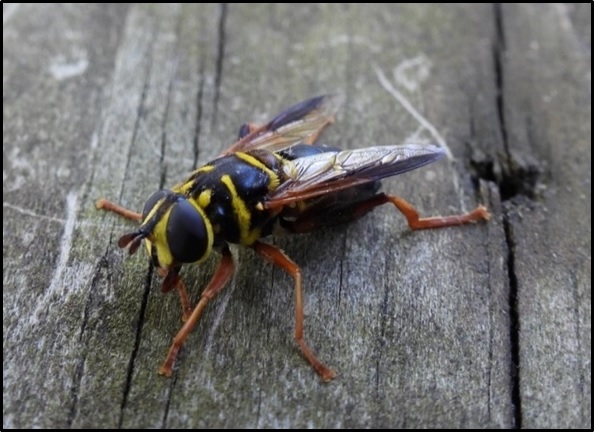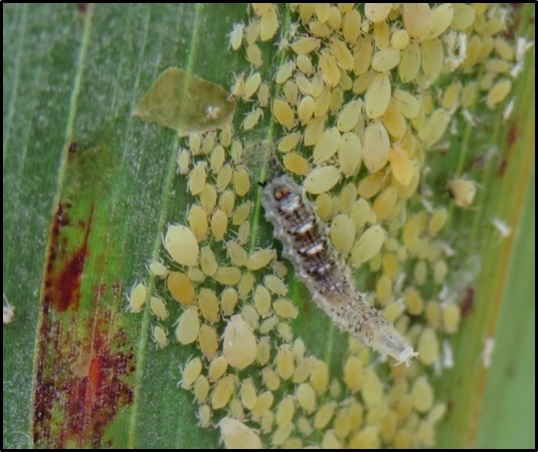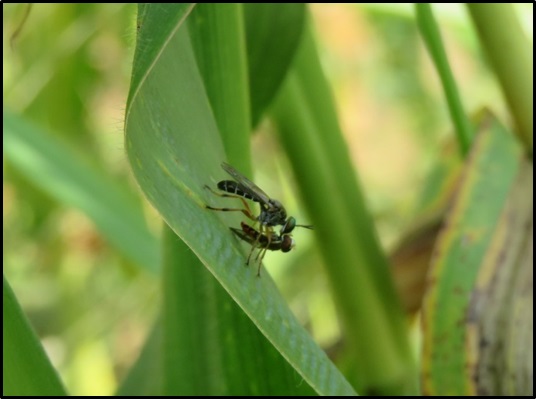Syrphid Flies: Overlooked Pollinating Insects
ENTFACT-710: Syrphid Flies - Overlooked Pollinating Insects | Download PDF
by Armando Falcon-Brindis, Entomology Research Associate and Raul T. Villanueva, Entomology Extension Specialist
University of Kentucky College of Agriculture, Food and The Environment
Overview
Syrphid flies, are also known as hover flies, flower flies, corn flies, or sweat flies. Adults are commonly found visiting flowers as they feed upon pollen and nectar, however, their role as pollinators is under appreciated. Hover flies display a characteristic hovering and abrupt changes in flight direction. Adults are often mistaken for bees and wasps due to their color patterns, black and yellow (Figure 1). However, hover flies do not sting or bite. Hover fly larvae have evolved different feeding habits including predation, parasitism, scavenging, plant feeding, and fungal spores feeding. Such adaptations have allowed syrphids to colonize different habitats such as freshwater, forests and deserts.
Figure 1. Example of the syrphid fly Meromacrus acutus found in eastern United States that mimics a yellow jacket wasp’s coloration. Photo: A. Falcon-Brindis
Life History
Depending on the species, females lay one or more eggs in marshes or under leaves or litter. Across their lifetime, females can lay from 100 to 1,000 eggs. The egg stage takes about 5 days. The larval color varies from green to yellowish and has a typical maggot shape. The larva lacks legs and eyes and has three larval instars. However, larvae of some aquatic syrphids are known as “rat-tailed” maggots because they display a long tail-like breathing tube. The mouth of predacious syrphid larva has pointed mouthparts used to pierce or tear their prey and suck the contents, whereas those feeding on plants have developed mandibles. Syrphid larvae prey on several soft-bodied insects such as aphids (Figure 2), scales, thrips, froghoppers, psyllids, or mites. A single hover fly larva can consume between 100 to 600 aphids during its lifetime, but this greatly varies among species. In the last instar, larvae pupate in the soil or on the plant. The life cycle takes 2 to 4 weeks to complete. Most syrphid flies overwinter as larvae in the soil and leaf litter. Depending on the region (i.e., climatic conditions), there are usually two or more generations per year. In Kentucky, adult flower flies are observed from mid-spring to early fall often visiting plants to obtain honeydew, nectar, pollen, or simply moisture (Figure 3).
Figure 2. Syrphid larva preying on sorghum aphids on a heavily infested leaf of forage sorghum. Photo: A. Falcon-Brindis.
Figure 3. Adult syrphid fly Toxomerus marginatus. Photo: A. Falcon-Brindis.
Syrphids have several natural enemies that can attack different stages across their life cycle. Eggs can be preyed on by minute pirate bugs (Orius spp.) and ants. Larvae are sometimes attacked by ants, spiders, or other predatory insects. Syrphid larvae often compete for aphids with ladybugs. There are reports of cannibalistic syrphid larvae. Adults also have many predators including spiders, robber flies (Figure 4) and other insects.
Figure 4. Robber fly feeding on an adult syrphid fly. Photo: A. Falcon-Brindis.
Benefits of Hover Flies
Hover flies are known to contribute to agroecosystems as larvae prey on pests and adults are pollinators. Under controlled conditions, hover flies can increase the seed production of onion, oilseed rape, sweet pepper, strawberry, and a variety of cultivated plants. Adult syrphids have a complementary role in pollen transport of wild plants.
Conservation of Hover Flies
While people can consider syrphid flies a nuisance because they fly near humans while they work outside and due to their coloration, people think the flies can sting or bite, but they are just trying to get moisture or salts out of our skin and are incapable of stinging or biting.
Hover flies are important insects, unfortunately, they are also highly susceptible to insecticides. Insecticides applied for control of aphids or other pest species reduce populations of syrphid larvae, and if aphid infestations are not reaching an economic level, insecticides should not be recommended if syrphid fly larvae are preying upon them.
Interesting Facts
- Hover flies are fast. They can reach ~8 mph, which is like if a Boeing 737 could fly 15 times faster (almost 9,000 mph!).
- Some species have specialized hairs to carry pollen, just like bees.
- There are syrphids capable of traveling 1,300 feet to carry pollen.
Issued: 05/03/2023
CAUTION! Pesticide recommendations in this publication are registered for use in Kentucky, USA ONLY! The use of some products may not be legal in your state or country. Please check with your local county agent or regulatory official before using any pesticide mentioned in this publication.
Of course, ALWAYS READ AND FOLLOW LABEL DIRECTIONS FOR SAFE USE OF ANY PESTICIDE!
Photos courtesy University of Kentucky Entomology




